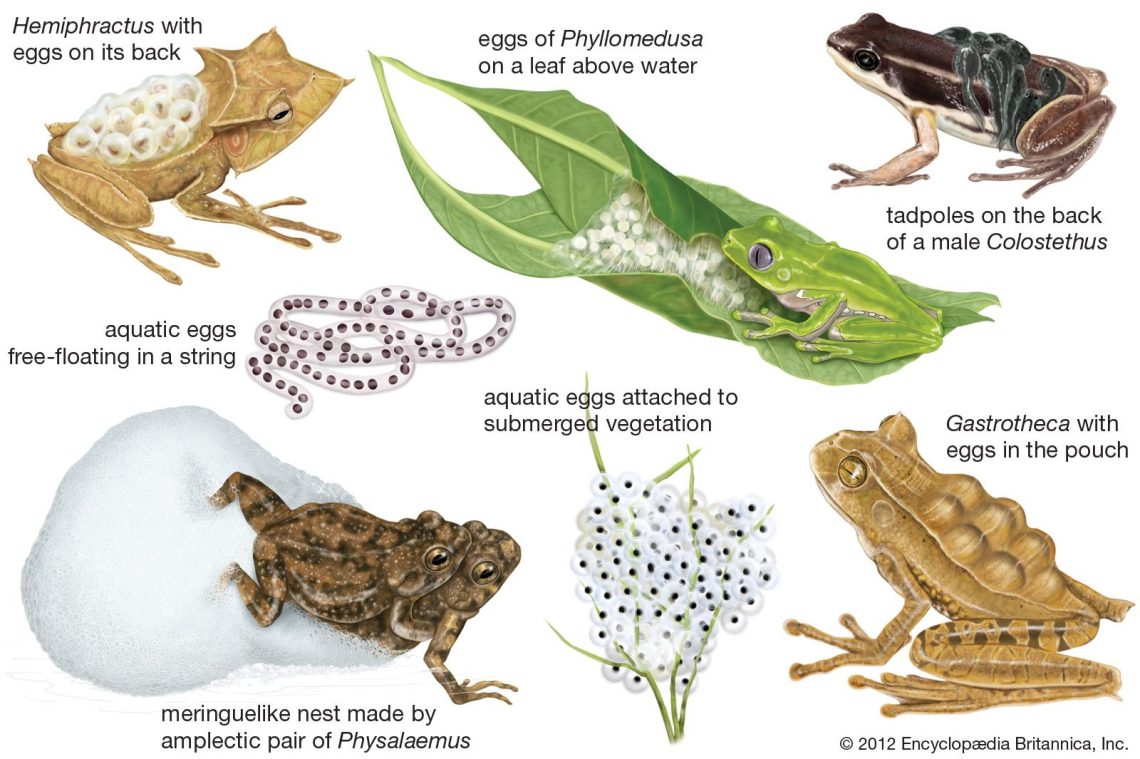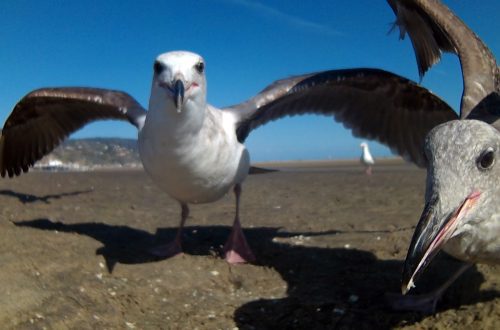
Reproduction of different types of frogs, how amphibians reproduce
Frogs can breed when they reach four years of age. Waking up after hibernation, mature amphibians immediately rush to spawning waters, where they search for a partner that is suitable in size. The male has to perform various kinds of tricks in front of the female in order to get her attention, such as singing and dancing, showing off with might and main. After the female chooses a boyfriend that she likes, they begin to look for a place to lay eggs and fertilize them.
Contents
Marriage Games
Vote
Most male toads and frogs attract females of their own species with a voice, namely croaking, which is different for different species: in one species it looks like a “trill” of a cricket, and in another it looks like the usual “qua-qua”. You can easily find the voices of males on the Internet. The loud voice on the pond belongs to the males, while the voice of the females is very quiet or absent altogether.
Courtship
- Appearance and coloration.
Males of many species of frogs, for example, tropical poison dart frogs, change their color during mating season, becoming black. In males, unlike females, the eyes are larger, the sense organs are better developed and the brain is enlarged, respectively, and the front paws are decorated with so-called marriage calluses, which are necessary for mating so that the chosen one cannot escape.
- Dance
The attention of females can be attracted and various movements. Colostethus trinitatis just bounce rhythmically on a branch, and Colostethus palmatus get into exquisite poses when they see a female on the horizon, and other species that live near waterfalls manage to wave their paws at females.
Male Colostethus collaris perform a courtship dance. The male crawls up to the female and croaks louder and faster, then crawls away, sways and jumps, while freezing on his hind legs in an upright position. If the female is not impressed by the performance, she raises her head, showing her bright yellow throat, this dares the male. If the female liked the male’s dance, then she watches the beautiful dance, crawling to different places in order to better see the male’s game.
Sometimes a large audience can gather: one day, while observing Colostethus collaris, scientists counted eighteen females that stared at one male and moved to another position in synchrony. Having danced, the male slowly leaves, while often turning around to make sure that the lady of the heart is following him.
In gold dart frogs, on the contrary, females fight for males. Having found a male who croaks, the female slaps her hind legs on his body and puts her front paws on him, she can also rub her head against the male’s chin. The male with less ardor responds in kind, but not always. Many cases have been recorded when this type of amphibian had fights between both females and males for a partner they liked.
Fertilization or how frogs reproduce
Fertilization occurring externally
This type of fertilization occurs most often in frogs. The smaller male tightly clasps the female with his front paws and fertilizes the eggs spawned by the female. The male embraces the female in the amplexus posture, which there are three options.
- Behind the front paws of the female, the male makes a girth (sharp-faced frogs)
- The male grabs the female in front of the hind limbs (scaphiopus, spadefoot)
- There is a girth of the female by the neck (dart frogs).
Fertilization inside
Few poison dart frogs (for example, Dendrobates granuliferus, Dendrobates auratus) are fertilized in a different way: the female and male turn their heads in opposite directions and connect the cloacae. In the same position, fertilization occurs in amphibians of the Nectophrynoides species, which first bear eggs, and then tadpoles in utero until the completion of the metamorphosis process and give birth to fully formed frogs.
Tailed male frogs of the genus Ascaphus truei have a specific reproductive organ.
During the breeding season, males quite often form specific mating rough calluses on their front paws. With the help of these calluses, the male clings to the slippery body of the female. An interesting fact: for example, in the common toad (Bufo bufo), the male climbs on the female far from the reservoir and rides on it for several hundred meters. And some males may ride the female after the mating process is complete, waiting for the female to form a nest and lay eggs in it.
If the mating process takes place in the water, the male can hold the spawned eggs by the female, pressing his hind legs in order to have time to fertilize the eggs (species – Bufo boreas). Quite often, males can mix up and climb on males who clearly do not like it. The “victim” reproduces a specific sound and vibration of the body, namely the back, and forces you to get off yourself. Females also behave at the end of the fertilization process, although sometimes the male himself can release the female when he feels that her abdomen has become soft and empty. Quite often, females actively shake off males who are too lazy to get off, turning over on their side and stretching their hind limbs.
Soitie — amplexus
Types of amplexus
Frogs lay eggs, like fish, since caviar (eggs) and embryos lack adaptations for development on land (anamnia). Various types of amphibians lay their eggs in amazing places:
- into burrows, the slope of which descends into the water. When a tadpole hatches, it rolls into the water, where its further development proceeds;
- the female with the collected mucus from her skin forms nests or lumps, then attaches the nest to the leaves that hang over the pond;
- some wrap each egg in a separate leaf of a tree or reed hanging over the water;
- female of the species Hylambates brevirostris in general hatches eggs in his mouth. Males of the species Darwin’s rhinoderm have special sacs in the throat, where they carry the eggs laid by the female;
- narrow-mouthed frogs live in arid areas, which lay eggs in damp soil, where a tadpole then develops, and a formed amphibian crawls onto land;
- females of the genus pipa carry eggs on themselves. After the eggs are fertilized, the male presses them into the back of the female with his belly, laying the eggs in rows. Eggs that stick to plants or to the bottom of a reservoir cannot develop and die. They survive only on the back of the female. A couple of hours after laying, a porous gray mass forms on the back of the female, into which the eggs are buried, then the female molts;
- some species of females form ring shafts from their own mucus;
- in some species of frogs, a so-called brood pouch is formed in the folds of the skin on the back, where the amphibian carries eggs;
- some Australian frog species eggs in the stomach and tadpoles. For the period of gestation in the stomach with the help of prostaglandin, the function of producing gastric juice is turned off.
For the entire period of tadpole gestation, which lasts two months, the frog does not eat anything, while remaining active. During this period, she uses only internal stores of glycogen and fat, which is stored in her liver. After the frog’s gestation process, the frog’s liver decreases in size by a factor of three and there is no fat left on the abdomen under the skin.
After oviposition, most females leave their clutch, as well as spawning waters, and go to their usual habitats.
Eggs are usually surrounded by large gelatinous layer. The egg shell plays a big role, as the egg is protected from drying out, from damage, and most importantly, it protects it from being eaten by predators.
After laying, after some time, the shell of the eggs swells and forms into a transparent gelatinous layer, inside which the egg is visible. The upper half of the egg is dark, and the lower half, on the contrary, is light. The dark part heats up more, as it uses the sun’s rays more efficiently. In many species of amphibians, clumps of eggs float to the surface of the reservoir, where the water is much warmer.
Low water temperature delays the development of the embryo. If the weather is warm, the egg divides many times and forms into a multicellular embryo. Two weeks later, a tadpole, a frog larva, emerges from the egg.
Tadpole and its development
After leaving the spawn tadpole falls into the water. Already after 5 days, having used up the supply of nutrients from the eggs, he will be able to swim and eat on his own. It forms a mouth with horny jaws. The tadpole feeds on protozoan algae and other aquatic microorganisms.
By this time, the body, head, and tail are already visible in tadpoles.
The head of the tadpole is large, there are no limbs, the caudal end of the body plays the role of a fin, a lateral line is also observed, and there is a sucker near the mouth (the genus of the tadpole can be identified by the sucker). Two days later, the gap along the edges of the mouth is overgrown with some semblance of a bird’s beak, which acts as a wire cutter when the tadpole feeds. Tadpoles have gills with gill openings. At the beginning of development, they are external, but in the process of development they change and attach to the gill arches, which are located in the pharynx, while already functioning as ordinary internal gills. The tadpole has a two-chambered heart and one circulation.
According to the anatomy, the tadpole at the beginning of development is close to fish, and having matured, it already resembles a reptile species.
After two or three months, the tadpoles grow back, and then the front legs, and the tail first shortens, and then disappears. At the same time, the lungs also develop.. Having formed for breathing on land, the tadpole begins its ascent to the surface of the reservoir to swallow air. Change and growth depend largely on hot weather.
Tadpoles at first feed mainly on food of plant origin, but then gradually move on to food of an animal species. The formed frog can get ashore if it is a terrestrial species, or continue to live in the water if it is an aquatic species. The frogs that have come ashore are underyearlings. Amphibians that lay their eggs on land sometimes proceed to development without the process of metamorphosis, that is, through direct development. The development process takes about two to three months, from the beginning of the laying of eggs to the end of the development of the tadpole into a full-fledged frog.
Amphibious poison dart frogs exhibit interesting behavior. After the tadpoles hatch from eggs, the female on her back, one by one, transfers them to the tops of trees into flower buds, in which water accumulates after rain. Such a kind of pool is a good children’s room, where children continue to grow. Their food is unfertilized eggs.
The ability to reproduce in cubs is achieved at about the third year of life.
After the breeding process green frogs stay in the water or keep on the shore near the reservoir, while brown go to land from the reservoir. The behavior of amphibians is largely determined by humidity. In hot, dry weather, brown frogs are mostly unobtrusive, as they hide from the sun’s rays. But after sunset, they have hunting time. Since the green frog species lives in or near water, they also hunt during daylight hours.
With the onset of the cold season, brown frogs move to the reservoir. When the water temperature becomes higher than the air temperature, brown and green frogs sink to the bottom of the reservoir for the entire period of winter cold.





